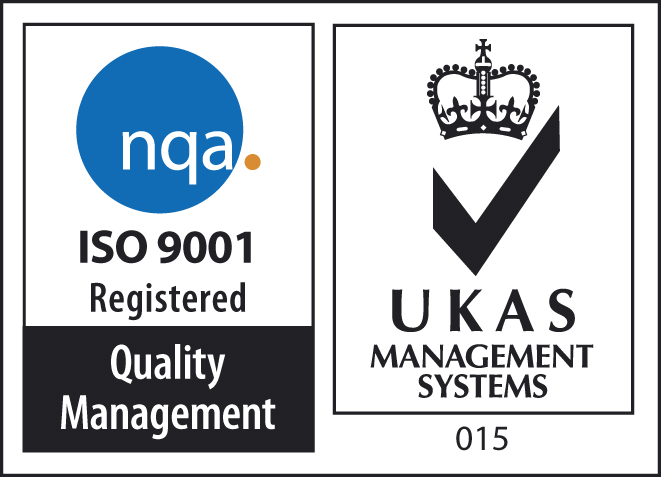海洋工程系泊系统
TTI对各种系泊系统进行初步和详细设计,例如:
- 供应船叉骨系泊分析与设计
- 开发用于系泊潜水船的分析工具
- 混合式深水系泊系统设计方法的开发
- 用于浮标立管的系泊绳缆的详细设计。
- 具有最小声学特征的特殊系泊系统。
- 用于研究设施的合成绳索拉紧系泊系统的设计。
系泊缆
TTI为单点系泊终端的运营商提供专业服务,特别强调优化系泊缆索更换策略。
- 系泊系统设计/重新设计
- 大规格绳缆选择和规格
- 建立绳缆的更换标准标准
- 疲劳寿命和残余强度预测
- 绳缆故障调查分析
- 绳缆检查和测试
深海系泊
非常深水域船舶系泊的工程设计具有挑战性,需要创新的解决方案。 新型布置和合成材料是深水系泊解决方案的特征,TTI处于该技术的最前沿,为该领域最近的大多数合作研究项目提供了领导或贡献。
- Fibre Tethers 2000.
- DEEPSTAR纤维绳缆系泊实验.
- 深海系泊设计方案指南.
- 大型纤维系泊绳缆测试
- 聚酯系泊绳缆寿命
有两个特殊概念,分别采用或组合采用,已经证明可以为非常深的水域提供相当大的停泊范围:
- 绷腿系泊
- 纤维绳缆系泊
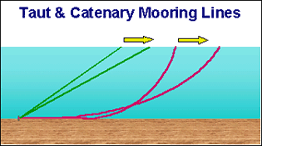
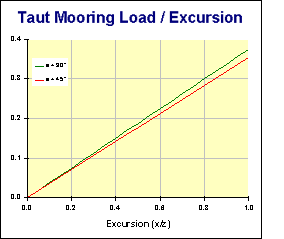
.gif)
TTI defines a taut leg as one where the line rises from the anchor under normal pretension, so there is no grounded line to lift off the seabed as line tension increases. Because of this, taut moorings work in a fundamentally different way to catenary moorings, their compliance deriving mainly from the elastic stretch of the lines, whereas a catenary mooring derives its compliance from the change in suspended line weight.
TTI将拉紧腿定义为在正常张力下从锚链上引出一段绳缆,因此当线张力增加时,没有接连接海床的部分。 因此,绳缆的系泊与悬链系泊是完全不同的方式工作。绳缆系泊主要来自于绳缆自身的弹性,而悬链系泊通过悬挂重量的变化来实现其顺应性。
A taut mooring leg will usually have an angle of between 30 and 45 degrees to horizontal at the vessel (determined from design considerations) and will exhibit fairly linear load-excursion characteristics which are related to this angle and the stiffness of the line.
拉紧系泊腿通常与船舶等的水平方向呈30到45度角(根据设计考虑确定)并且将表现出相当好的载荷-偏移线性特征,该线性特征与绳缆的刚度和角度相关。
Because taut moorings have a much more linear stiffness than the progressively stiffening catenary systems, offsets under mean load can be better controlled and vessel motions do not induce such a high proportion of total line tensions.
由于绳缆系泊比悬链系泊具有更大的线性刚度,因此可以更好地控制平均载荷下的偏移,并且船舶运动不会引起如此高的总线张力比例。
A further advantage is the better load sharing between adjacent lines than is typical of a catenary array, so improving overall efficiency of the system.
另一个优点是,相对于悬链系泊系统,绳缆系泊系统可以在相连的绳缆之间更好的分配载荷,因此可以提高整个系统的效率。
The taut mooring also overcomes another limitation of deepwater catenarys by having much shorter lines. Scopes of under 2, compared to 5 or more with catenary systems, save material and give a more compact seabed footprint.
同时,绳缆系泊系统还克服了悬链系泊系统的另一个不足。绳缆系泊系统中绳缆长度更短。因此,可以节省材料,使得海床锚点的布置更加紧凑。
The lines of a taut mooring need to have sufficient elasticity to absorb the vessel wave motions without over loading. Where motions are low either because of benign wave environment (eg. West Africa or Brazil) or because of the vessel characteristics, (as a SPAR for example), wire ropes may be appropriate, particularly in deep water where there is the line length to develop enough stretch. However, the weight of steel mooring wires in very deep waters may become too much of a penalty on the vessel payload and, furthermore, strength utilisation is reduced as more of the line tension capacity will be used in keeping the wire taut.Synthetic Rope Moorings
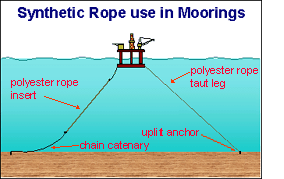
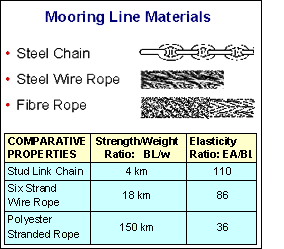
Synthetic fibre ropes offer a potential solution to the weight problems of using steel mooring lines in deepwater as they have a very low weight in water.
Also, compared to steel, there are a vary large number of synthetic fibre material compositions with a wide range of material properties. A synthetic rope can therefore be designed to have properties that match the mooring requirements.
Materials that have potential for mooring line application include:
- Nylon
- Polyester
- Aramid (Twaron, Technora and Kevlar)
- Liquid Crystal Polymer
- High Modulus Polyethylene (HMPE)
Yarns of these synthetic materials may be built into ropes using a number of constructions, some of which are suited to particular fibres.
Some of the issues which affect choice of yarn material and the rope construction are:
- Load-extension behaviour
- Internal heating
- Durability & fatigue endurance
- Termination & end fittings
- Wear & abrasion
- Handling & installation
Synthetic ropes can be used as a lightweight insert in a catenary mooring (usually having a chain catenary segment touching down on the seabed). However, their real potential lies in taut moorings where ropes combining low weight and low elastic modulus with good durability characteristics, will enable efficient mooring systems to be designed for a whole range of water depth and environmental conditions.
The currently favoured synthetic material is polyester for reasons of cost and good fatigue endurance. Polyester has also been used in rope constructions for several years, and the issues of manufacture and end termination for large rope sizes have been satisfactorily resolved. Polyester ropes also have elasticity in the range most suitable for taut mooring of vessels with typical wave motions in very deep and ultra deep water depths up to around 1500 metres (5000 feet).
Optimoor
TTI have developed an advanced computer program Optimoor for analysing the complex behaviour of moored vessels under any environmental conditions. The software enables rapid assessment of moorings to OCIMF requirements and is licensed to port operators worldwide. Both quayside and offshore moorings are handled by Optimoor.
海洋工程系泊系统设计
您位于服务页面

